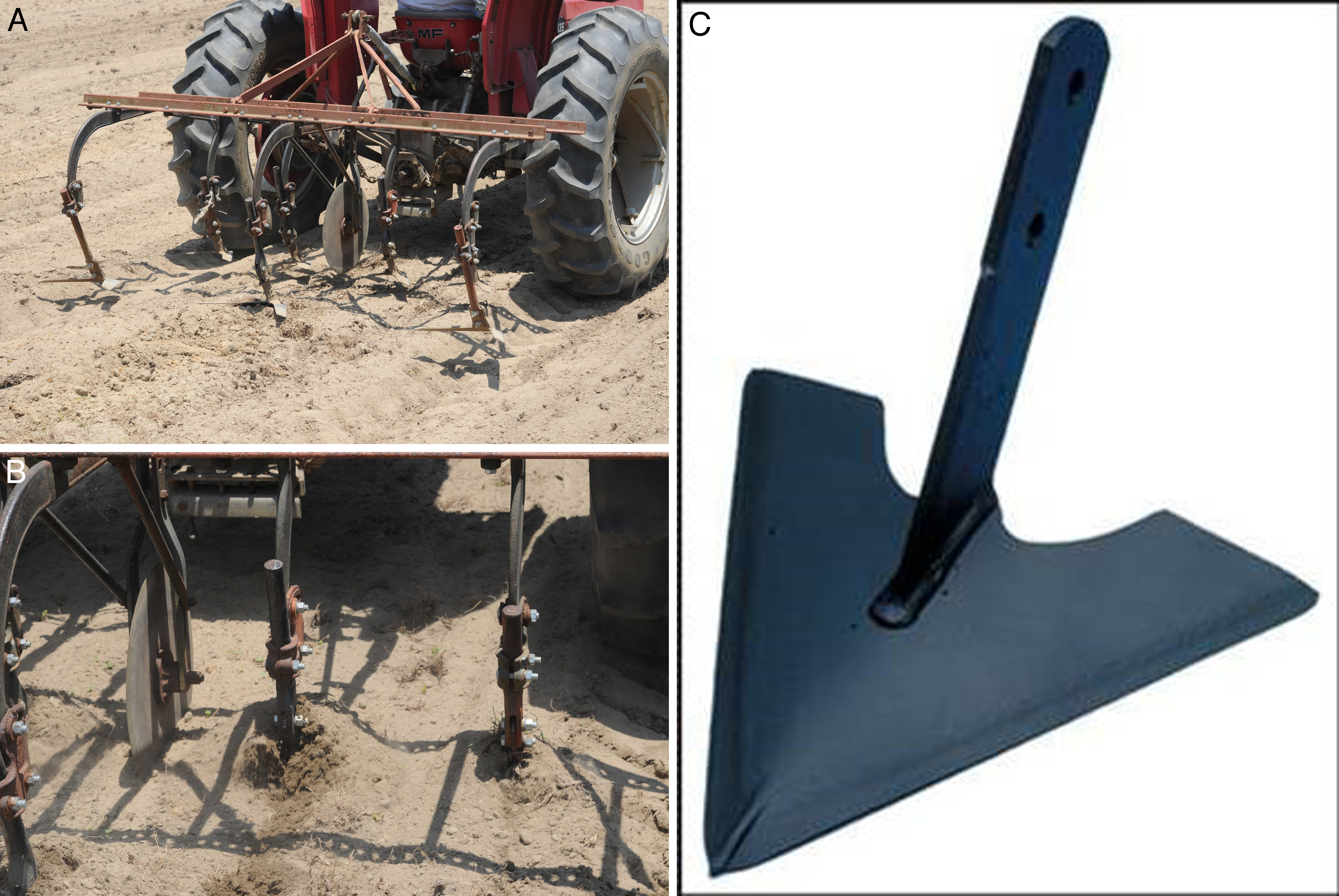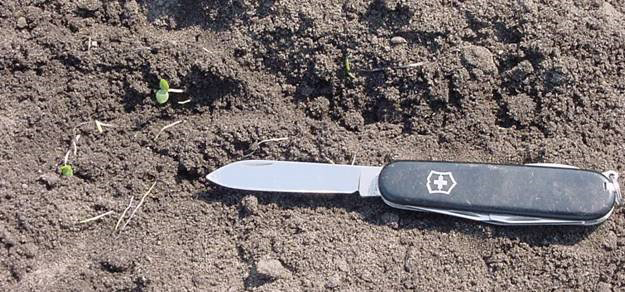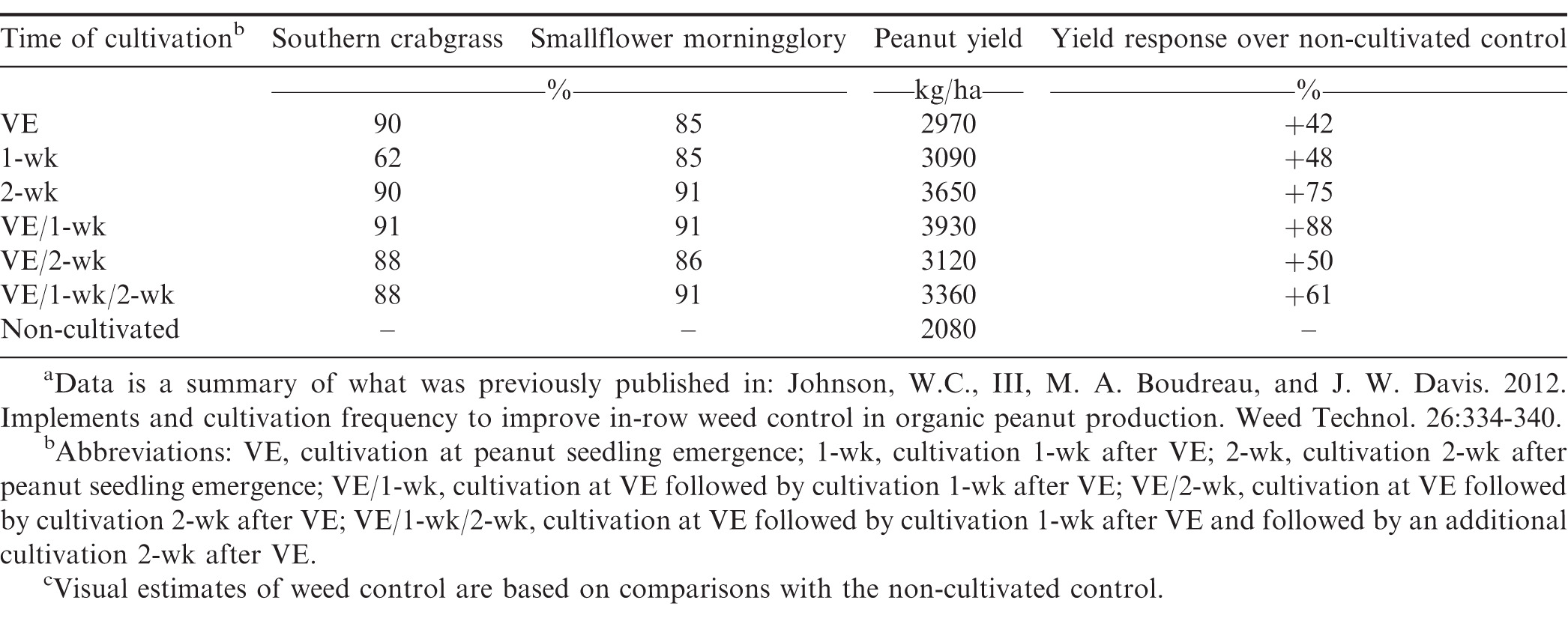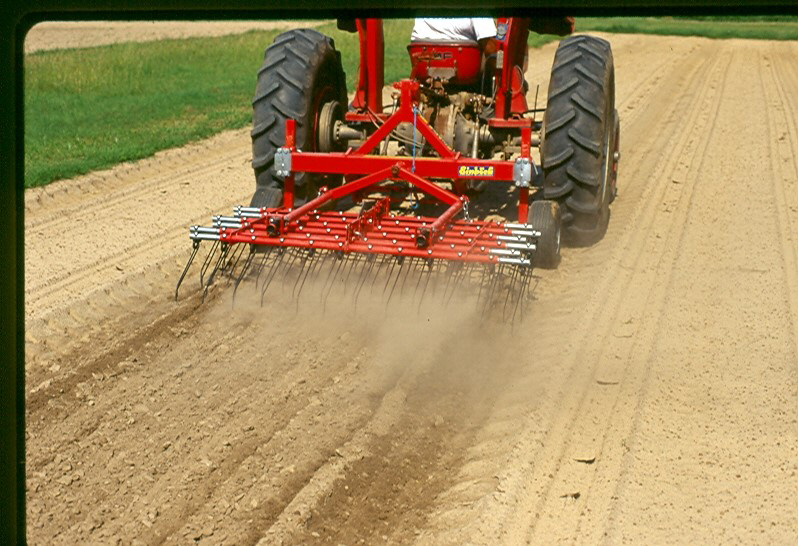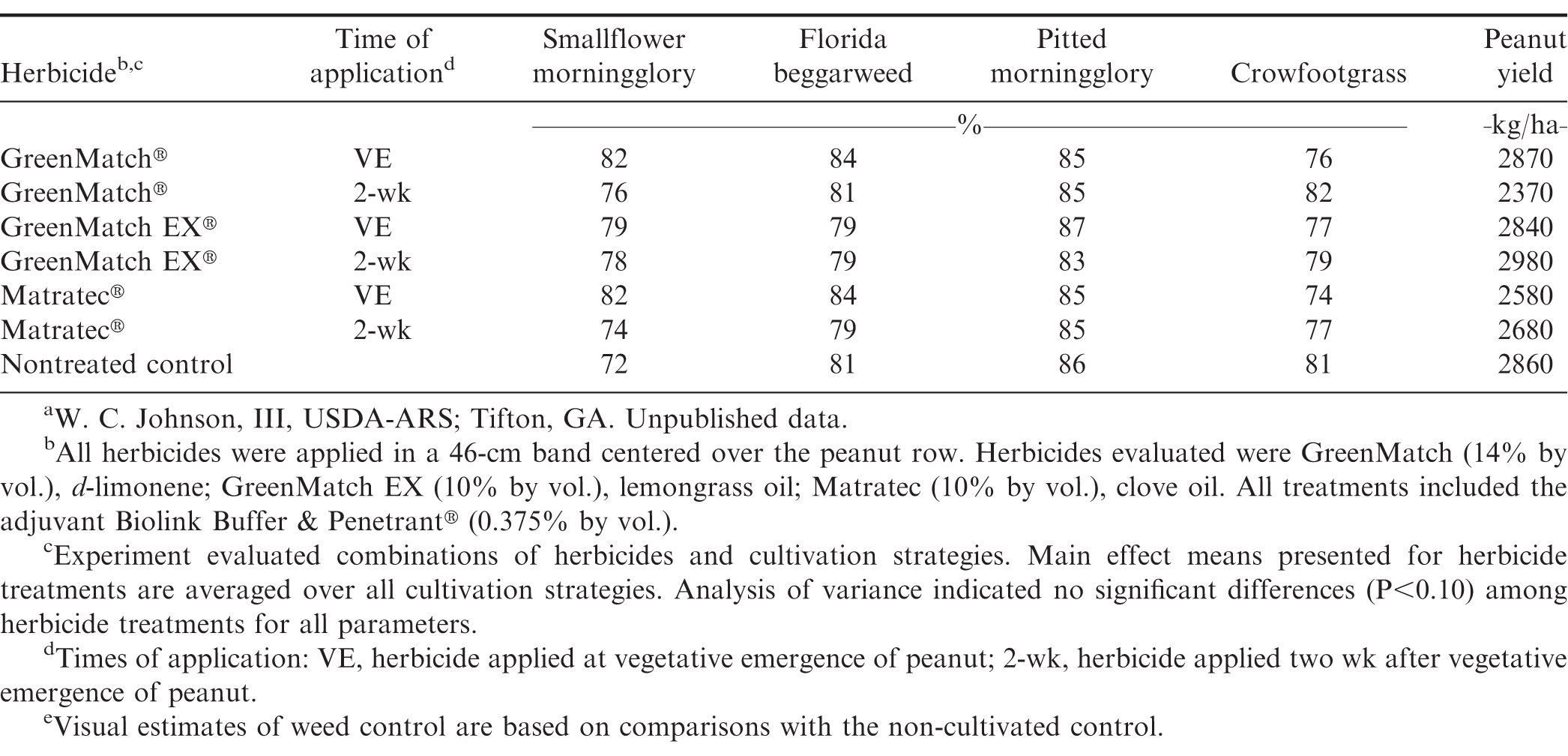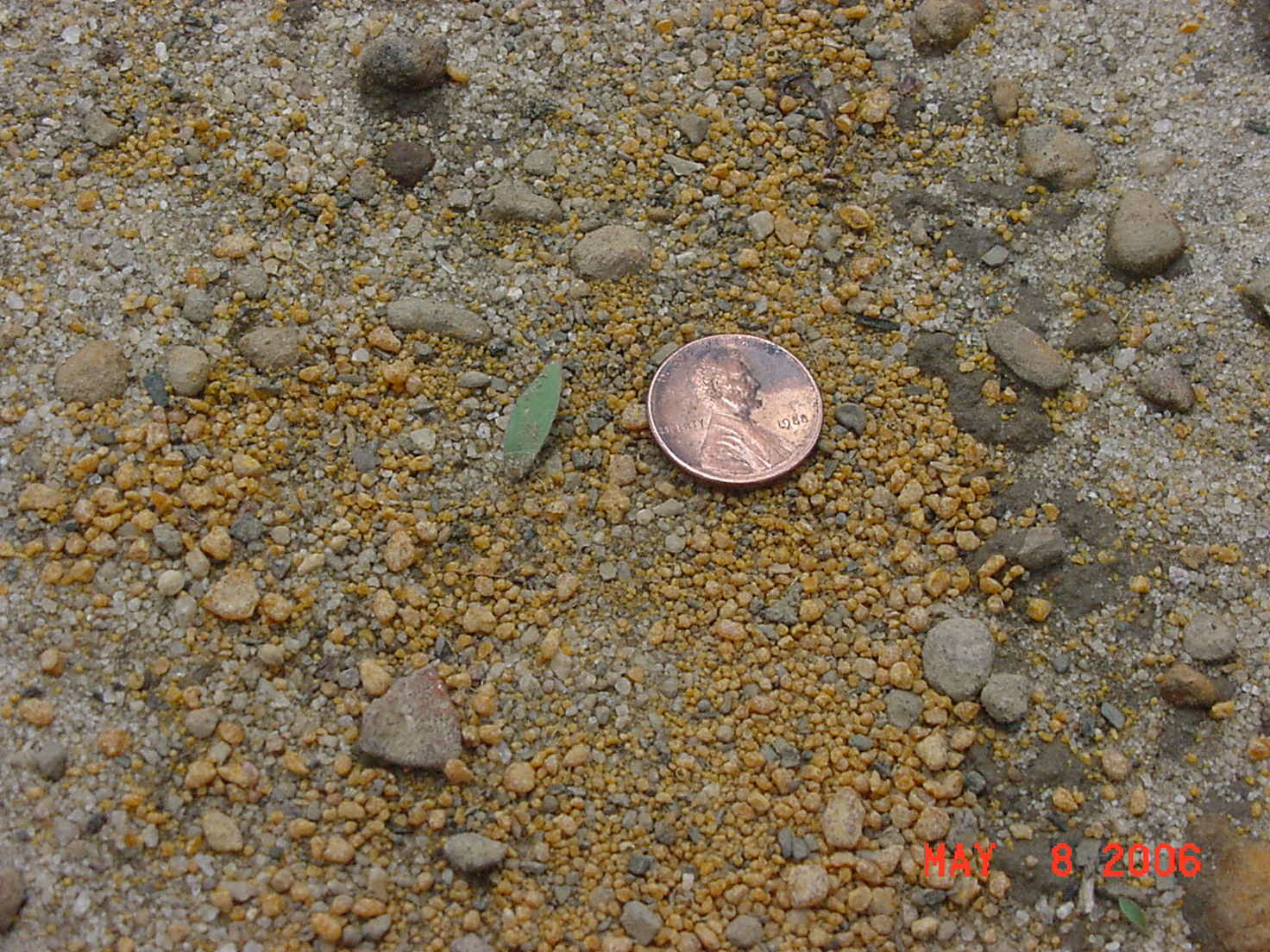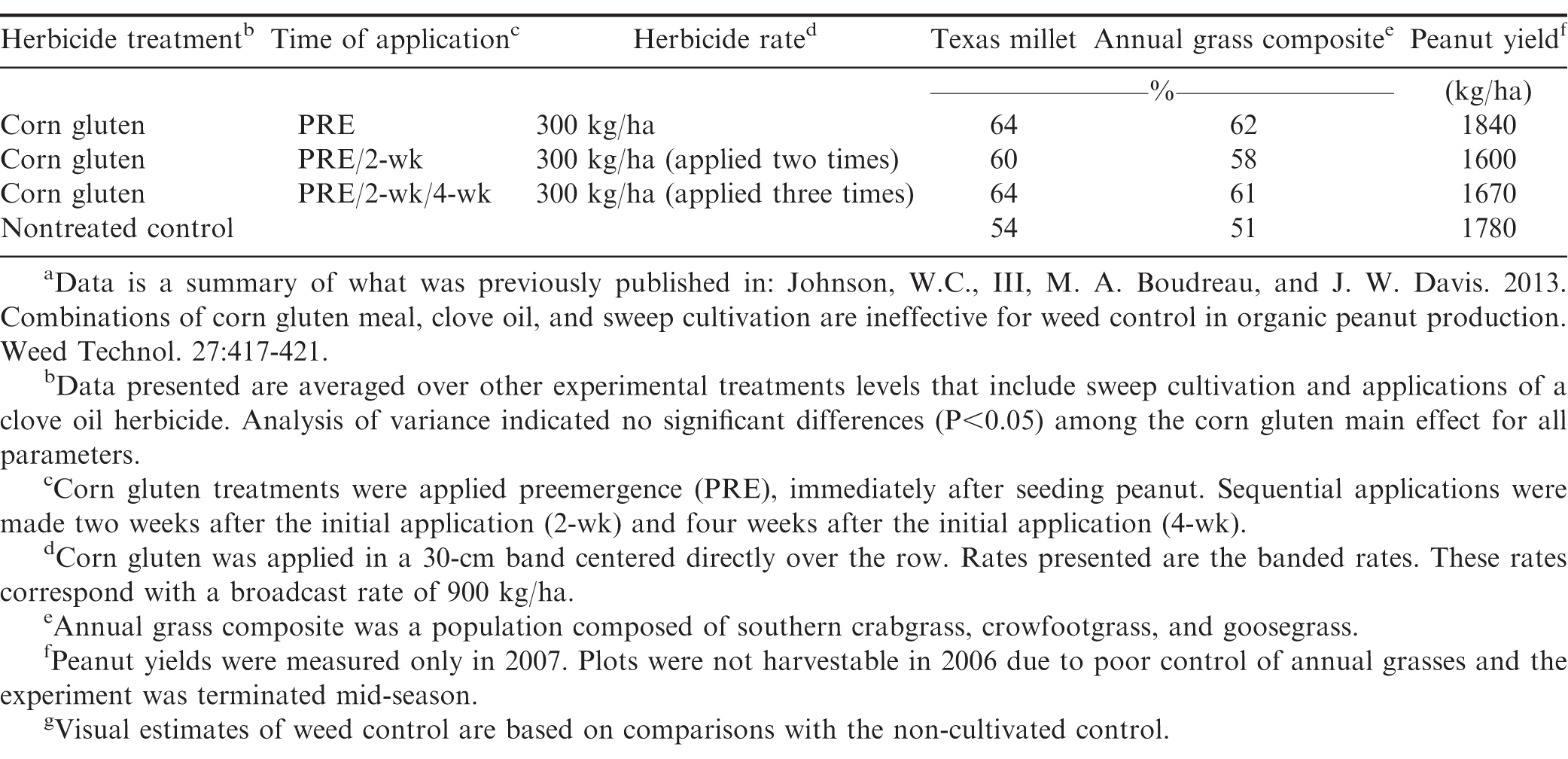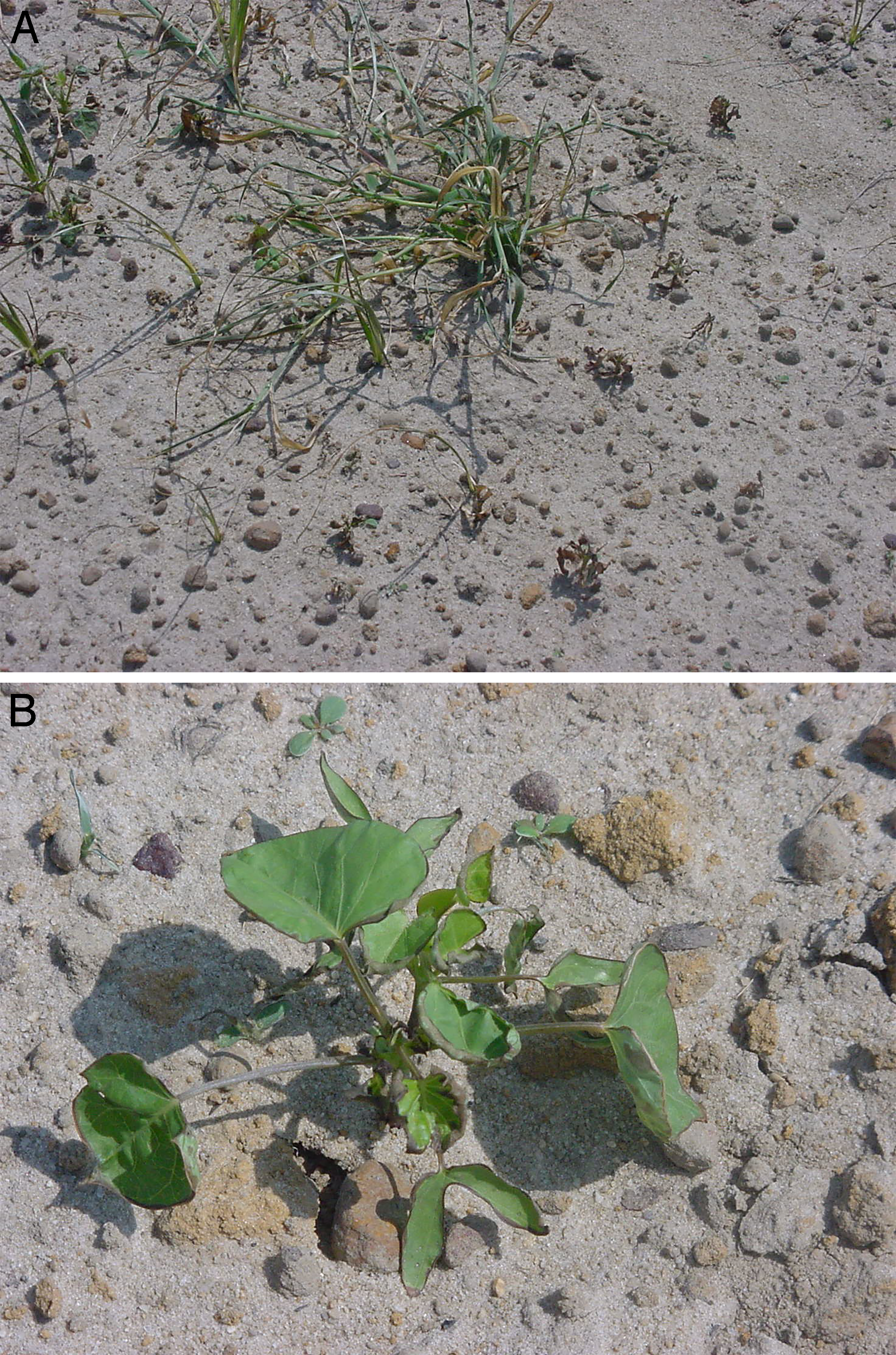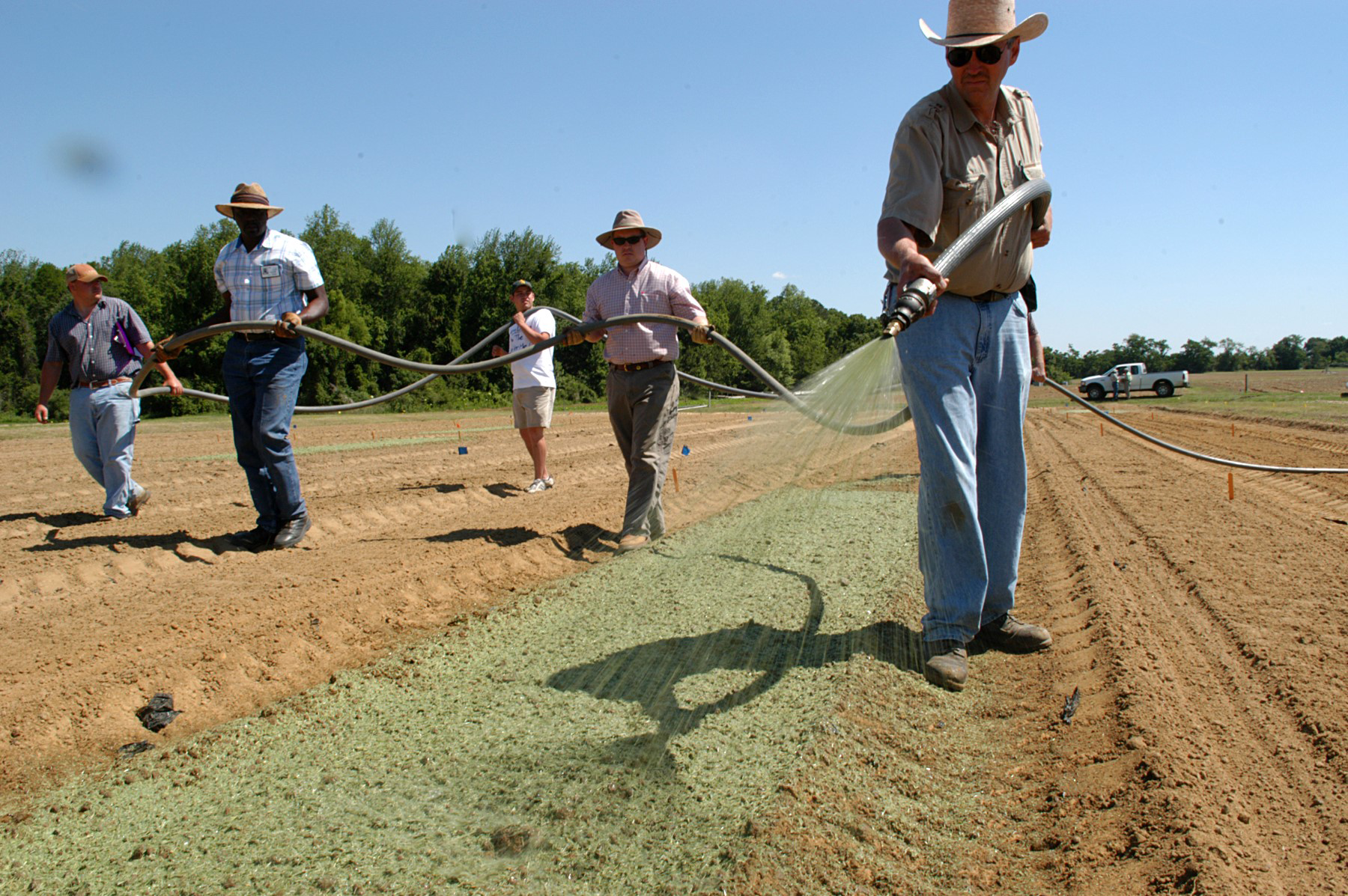Introduction
Weeds and their Losses in Organic PeanutWeed management is universally considered to be the major limiting factor in organic crop production and has been identified as a research priority by organic growers (OFRF, 2016). Weed management in organic cropping systems is conceptually based on integrated weed management; a system of cultural practices, mechanical controls, and substituted inputs. Guidelines for certified organic crop production restrict dependence on a single facet of weed control and stipulate that weed management based on a system of all available options suitable for the crop production system (Anonymous A, 2019).
Weeds and their losses
Weeds cause losses in peanut production due to competition for limited resources necessary for crop growth; primarily light and water. The degree to which weeds compete with peanut and reduce yield varies among weed species and environments in which the plants interact. As a group, annual grasses are among the most competitive weeds with peanut; with 1.1 goosegrass [Eleusine indica (L.) Gaertn.] plants/m2 (McCarty, 1983), 0.9 broadleaf signalgrass [Urochloa platyphylla (Munro ex C. Wright) R. Webster] plants/m2 (Chamblee et al., 1982), 2.0 fall panicum (Panicum dichotomiflorum Michx.) plants/m2 (York and Coble, 1977), and 2.2 Texas millet [U. texana (Buckley) R. Webster] plants/m2 (Johnson and Mullinix, 2005) reducing peanut yield by 25%. In contrast, yellow nutsedge (Cyperus esculentus L.) is not overly competitive with peanut, with 25% peanut yield reductions occurring at much higher densities, 68 plants/m2 (Johnson and Mullinix, 2003). Bristly starbur (Acanthospermum hispidum DC.), Florida beggarweed [Desmodium tortuosum (Sw.) DC.], and sicklepod [Senna obtusifolia (L.) H.S. Irwin & Barneby] are among the most common dicot weeds in peanut and densities that cause 25% yield reduction are 2.3, 6.2, and 7.2 plants/m2, respectively (Hauser et al., 1982; Walker et al., 1989). These threshold values should not be viewed as absolutes, but rather illustrate that weeds are not equal in terms of weediness and competiveness.
Peanut produces subterranean fruits that require a two-step harvesting process; digging/inversion and combining. Both phases of peanut harvest can be inhibited by the presence of weeds. As mentioned earlier, annual grasses are among the most troublesome weeds of peanut and a factor for this distinction are the heavy harvest losses when annual grasses infest the crop. Annual grasses produce an extensive fibrous root system that entangle peanut pods as the crop is being dug, resulting in significant season-long harvest losses. Johnson and Mullinix (2005) determined that Texas millet at a density of 2 plants/m2 caused harvest losses of 836 kg/ha, which is in addition to yield reduction from competition. Tall weeds such as Florida beggarweed, lambsquarters (Chenopodium album L.), and Palmer amaranth (Amaranthus palmeri S. Watson) cause unique losses in peanut, along with losses caused by competition. Tall weeds affect harvest by interfering with inverting the peanut crop into windrows. Furthermore, tall weeds also tend to have large-diameter stems and roots, which accelerate wear and damage to peanut combines.
An overlooked loss that weeds cause in peanut production is the cost of weed control. Organic peanut growers tend to spend more for weed control than conventional peanut growers due to the continued reliance on costly handweeding. This cost is directly related to the time needed to remove weeds by hand; the greater the weed density, the longer it will take and at greater expense (Wann and Tubbs, 2014).
The point of this discussion about weeds and their losses is to emphasize the extreme importance of effective weed management in organic peanut production. All weeds are capable of causing losses, although weeds vary in competitiveness. The vulnerability of peanut to weeds is expressed in many unique ways, which is also clear indication of the importance of weed control in organic peanut production.
Integrated Weed Management in Organic Peanut Production
Cultural Weed Control
Cultural weed control can be defined as modifying crop production practices to help peanut suppress weeds and minimize losses. Since cultural weed control is fundamentally designed around the actual production practices of the crop, it should be the foundation on which an integrated weed management system is developed.
Planting Dates
Peanut planting dates in the southeastern U. S. range from mid-April through May, with actual planting dates influenced by many factors unique to each peanut farming operation. Deviations from this range of planting dates increase risk for stand loss. Within the recommend range of planting dates, factors that directly influence planting include soil temperature, moisture, and logistics related to land preparation. Early planting dates pose the risk of cool soils that impede peanut seed germination and emergence. Late planting dates may avoid the problems associated with cool soils, but issues related to soils being too hot become equally important. In either case, temperature extremes may reduce peanut seed germination and emergence, resulting in a non-uniform peanut stand that affects competiveness of peanut with weeds.
In conventional peanut production, the minimum soil temperature for planting peanut is three consecutive days of 5 cm soil temperature averaging ≥18 C. However, this recommendation is for peanut seed treated with synthetic fungicide protectants, which are prohibited materials for organic crop production. Nontreated seed are planted for organic peanut production. In this case, anecdotal experiences have shown that the target soil temperatures should be three consecutive days of 5 cm soil temperature averaging ≥27 C, with consistent temperature patterns forecast for several days after planting. If situations arise when organic peanut are to be planted later in the summer, on-farm experiences have indicated that 5 cm soil temperatures averaging >35 C will reduce peanut seed germination and emergence.
While there has been no specific research on soil temperature limitations for planting nontreated peanut seed for organic production, poor peanut stands resulting from planting when soils are either too cold or too hot will create areas of bareground in the row. Weeds are very difficult to control in the resulting voids due inability of peanut plants to quickly shade the soil surface. With limited weed control options, it is prudent for organic peanut growers to wait to plant peanut when soil conditions are optimal. Ideal planting conditions will enhance the peanut crop's ability to suppress weeds.
Row Spacing and Seeding Rate
Peanut are commonly seeded in single rows spaced 91 cm apart, with seed uniformly spaced to produce a final stand 20 to 26 peanut plants/m in each row. Since peanut seedlings are slow to achieve canopy closure in this row spacing, there has been a continual effort to develop production systems using multiple narrow-spaced rows (usually four rows per seedbed) to quicken canopy closure and suppress weed emergence (Buchanan and Hauser, 1980; Colvin et al., 1985; Cox and Reid, 1965; Johnson et al., 2005). In conventional production systems, neither weed control was improved nor herbicide use reduced in peanut seeded in narrow rows compared to the crop seeded in wide rows. However, peanut yields were consistently greater when seeded in narrow rows compared to wide rows. Additionally, it was determined in the 1990s that peanut seeded in narrow row patterns was an important component in the integrated management of spotted wilt virus (tomato spotted wilt tospovirus) (Brown et al., 2003; Todd et al., 1996). In 2003, informal surveys of county agents indicated 41% of the peanut acreage in Georgia was planted in narrow row patterns, which is a substantial increase compared to 8% in 1984 (unpublished data). This increase is largely due to reduced spotted wilt incidence in peanut seeded in narrow row patterns.
In practice, changing row patterns is not a simple decision and extends beyond the fixed cost of new planters. Peanut seed are among the most costly inputs in peanut production. Seed cost is further increased since the seeding rate is 10 to 20% greater in narrow rows compared to wide rows. Peanut seed are placed to produce a final stand of 10 to 13 seedlings/m in each row in narrow row patterns and the overall 10 to 20% increase in seeding rate (kg seed/ha) is to compensate for reduced planter efficiency at wide seed spacings. Even when the desired final stand is achieved, peanut seedlings are spaced further apart in narrow row patterns compared to wide row patterns.
With the proven benefits of narrow row patterns in conventional peanut production, it was intuitive to determine if the same benefits extend to organic peanut production. Research conducted in Tifton, GA from 2008 to 2010 evaluated the effect of row pattern and seed spacing on weed management in organic peanut (Johnson et al., 2012a). When peanut were seeded in narrow row patterns at the recommended seeding rate (final spacing of 10 to 13 peanut seedlings/m in each row), weed control using cultivation was less effective compared to peanut seeded in wide row patterns (final spacing of 20 to 26 seed/m in each row) (Table 1). In the same study, when the recommended seeding rate was doubled in narrow row patterns, weed control from cultivation was improved, although peanut yields did not differ (data not shown). The results of these studies show two important points of cultural weed control. First, peanut seeded in narrow row patterns at the recommended seeding rate produces a peanut stand too sparse in the row for peanut to adequately suppress weeds in organic production systems. In contrast, peanut seed in wide rows at the recommended seeding rate produces a peanut stand that is capable of suppressing weeds in the row, when supplemented with timely cultivation that controls weeds in the row middle. Second, while the intra-row plant spacing in peanut appears to be an important cultural weed control component, too high of a peanut seeding rate is costly and provides no benefit. Based on these results, it is recommended that organic peanut be planted in wide row spacings (rows approximately 91 cm apart) at a seeding rate to produce a final stand of 20 to 26 plants/m of row.
Mechanical Weed Control
Mechanical weed control is the use of tools or manual labor to remove, cut, or disrupt weed growth in a manner that does not harm the crop. Mechanical weed control is conceptually simple, but complicated by limitations of equipment design, operation, and cost.
Cultivation
A common form of mechanical weed control is cultivation with implements that cut or displace weeds between the crop rows. Historically, crops were planted in rows to allow cultivation for weed control; first powered by draft animals, and then by tractors. The most common cultivator design cuts weeds using uniquely shaped blades (sweeps) that slice just under the soil surface in the area between the crop rows (Figure 1). Another cultivator design uses ground-driven circular cutters ('rolling cultivator'). Skilled operators cultivate as close as practically possible to the crop row to improve weed control.
The unique morphology of the peanut plant limits the aggressiveness and duration of cultivation using these designs. Subterranean fruiting can be disrupted by cultivation using sweeps that may unintentionally sever pegs and pods. Furthermore, Boyle (1952, 1956, 1961) correlated the incidence of stem rot (Sclerotium rolfsii Sacc.) of peanut (also called white mold, southern blight) with cultivation that displaced soil containing fungal sclerotia onto the lateral branches of peanut. Those findings were the basis for cultivation strategies that resulted in minimal soil disturbance; the so-called 'non-dirting' cultivation.
Another cultivator design commonly used in Europe is a tine-weeder (Colquhoun and Bellinder, 1997). The tine weeder is a series of spring-steel rods arranged in multiple rows that displace seedling weeds using vibratory action of the tines. All tine weeder designs are very effective on annual grasses and seedling dicot weeds with fibrous root systems, with maximum performance occurring when weed seed have germinated, but seedlings not fully emerged. Gunsolus (1990) referred to this stage of weed development as 'weeds in the white', with the white portion being the rapidly developing hypocotyl from a very young weed seedling (Figure 2). At this stage of growth, the vibratory action of the tines effectively disrupts weed seedlings. Subsequent weed flushes are controlled when tine weeding is repeated at regular intervals. A critical factor for satisfactory performance with the tine weeder is to begin cultivation in organic peanut when no emerged weeds are visible (Johnson and Davis, 2015; Johnson et al., 2012a, 2012b).
Research conducted at the University of Georgia Tifton Campus showed the importance of early season cultivation for weed management in organic peanut (Johnson and Davis, 2015; Johnson et al., 2012a, 2012b; Wann et al., 2011). Successful weed control using a tine weeder requires that the cultivation regime begin when peanut were at the vegetative emergence (VE) stage of growth, commonly called 'cracking', and repeated at weekly intervals for six to eight weeks. This regime effectively controlled southern crabgrass [Digitaria ciliaris (Retz.) Koeler] and smallflower morningglory [Jacquemontia tamnifolia (L.) Griseb.] (Table 2). Results from other trials showed effective Texas millet, crowfootgrass [Dactyloctenium aegyptium (L.) Willd.], and Florida pusley (Richardia scabra L.) control with the same cultivation regime. This level of weed control increased peanut yields by 42 to 88% over the non-cultivated control. Successful weed control using the tine weeder is dependent on conditions that allow cultivations to be timely with no delays and dry soil conditions that allow optimum implement performance. Weather-related delays in cultivation usually result in inconsistent overall weed management.
Peanut are not immune to damage from the tine weeder and the implement must be used with care. Interactive effects of depth (aggressiveness) and timing of the tine weeding greatly affect the peanut crop's tolerance to cultivation. An effective use of the tine weeder is cultivation prior to peanut emergence, which often coincides with weed emergence. Peanut are commonly seeded 5 cm deep and it takes five to seven days to emerge from this depth of seed placement. The time interval between seeding and peanut emergence provides organic peanut growers an excellent opportunity to aggressively cultivate with a tine weeder (Figure 3). At this stage of peanut development, non-emerged peanut seedlings are nearly immune to damage from the tine weeder. This allows for aggressive action of the tines, including those aligned over the peanut row. Previous research demonstrated that weed control with an initial cultivation before weed emergence is instrumental in ensuring overall success in weed control in organic peanut (Johnson and Davis, 2015; Johnson et al., 2012a, 2012b) and these findings have been validated by grower experiences.
After peanut emergence, care and patience are needed when adjusting the tine weeder. Downward pressure of tines aligned with the peanut row must be lessened to protect developing seedlings, with continual adjustment in downward pressure of adjacent tines as the crop grows (Figure 4). While a tedious process, adjusting downward tension of tines is not complicated. Attentiveness to tine adjustment greatly influences overall success of weed control and peanut tolerance to cultivation with a tine weeder.
While the tine weeder is a very useful and versatile implement, there are situations where a sweep cultivator is a better choice and is often used to supplement the tine weeder. Despite all efforts, conditions may arise where weeds have already emerged. In this case, using a sweep cultivator is a prudent choice since it uses the cutting action of the sweeps to slice emerged weeds, compared to the disruptive vibratory action of the tine weeder to which emerged weeds are somewhat tolerant. Additionally, dicot weeds with a pronounced taproot are often not effectively controlled with the vibratory action of the tine weeder and sweeps are a better choice for these weed infestations.
The rotary brush-hoe is a specialized mechanical weed control implement and offers promise in organic peanut. The brush hoe is a PTO-powered weed control implement with an array of rotating brushes to aggressively scour the soil surface. Typically, the brush-hoe scours the seedbed between the crop rows, with a rear-steering linkage (operated by a rider) guiding the brushes as close as possible to the crop row (Colquhoun and Bellinder, 1997). Research conducted by the USDA-ARS in Tifton, GA used the brush hoe in a conceptually different manner (Johnson et al., 2012b). Since peanut are seeded to depths of 5 cm, it was hypothesized that the brush-hoe operating directly over the row before peanut emergence would scour the soil surface of weeds, without affecting non-emerged peanut seedlings. In practice, this was found to be difficult, but not impossible, to achieve. The implement does not have precise depth adjustments and modifications were made to stabilize the implement, which improved overall implement performance. While these modifications provided improvement, small differences in field topography or seedbed uniformity caused the brushes to either scour too deep or fail to contact the soil surface. The resulting weed control was inconsistent compared to the tine weeder. Furthermore, operating cost in 2008 of the brush-hoe was estimated to cost $69/ha, compared to $26/ha to cultivate with a tine weeder (D. Kiser and N. Smith, Univ. of Georgia, personal communication).
Handweeding
Removal by hand has been the default weed control option for organic crop production systems and in many cases unavoidable. Labor for handweeding is both costly and often limited by inconsistent availability. Handweeding costs vary according to weed infestation (Wann et al., 2011). In trials conducted in Tifton, GA handweeding costs were estimated to be >$1480/ha in plots with poor weed control and with heavy weed infestations (W. C. Johnson, III; USDA-ARS; unpublished data). In contrast, handweeding costs to control sparse escapes in plots with good weed control from cultivation were $77/ha. Furthermore, heavy weed infestations often discourage field workers resulting in sloppy performance or outright abandonment of the work assignment. Research and on-farm demonstrations have shown that handweeding should be viewed as a supplemental tactic that controls escapes, not the primary method of weed control in organic peanut (Wann and Tubbs, 2014).
Chemical Weed Control (Herbicides)
There is a limited selection of herbicides suitable for use in certified organic crop production and these herbicides are derived from natural products. A comprehensive list of herbicides suitable for use in certified organic crop production is available (Anonymous B, 2019). The Organic Materials Review Institute (OMRI) determines if substituted inputs (herbicides) can be used in certified organic crop production without jeopardizing the organic certification. However, OMRI certification does not ensure adequate weed control or crop safety.
Essential Oils
Herbicidal oils derived from plants are termed essential oils. These compounds have many industrial, cosmetic, and pharmaceutical uses, along with herbicidal properties (Dayan et al., 2009). Herbicides derived from essential oils that have been evaluated for weed control in organic peanut include clove oil, d-limonene, lemongrass oil, and cinnamon oil as the primary herbicidal agents. Commercial herbicides may include one or several types of essential oils and inert compounds that improve handling properties.
Herbicides derived from essential oils are foliar-applied, contact herbicides that disrupt cellular membranes (Tworkoski, 2002). These herbicides are applied to emerged weeds and will not control non-emerged weeds or affect weed seed in the soil. In general terms, herbicides applied from essential oils are considered non-selective. Fortunately, peanut are somewhat tolerant and quickly recover from direct applications of essential oil herbicides with no yield effects (Johnson and Mullinix, 2008a).
Essential oil herbicides are generally efficacious on seedling dicot weeds and do not adequately control grasses or perennial nutsedges (Cyperus spp.) (Table 3). Efficacy is dependent on rate, stage of weed growth, environmental conditions, and sprayer configuration. Rates listed on product labels are cited as a range and the most consistent efficacy was achieved from the high portion of the rate range. Seedling weeds are more consistently controlled than larger weeds. Efficacy of any contact herbicide, including those derived from essential oils, is directly affected by environmental conditions at the time of application. In general terms, weather conditions that stress plants will reduce weed control with essential oil herbicides. In organic peanut production, weather conditions that reduce herbicide efficacy would typically be prolonged heat and drought. Contact herbicides require complete coverage of targeted weeds to achieve maximum efficacy, which requires proper sprayer configuration. To correctly apply essential oil herbicides, sprayers must be calibrated to produce an output of approximately 470 l/ha using high-output spray tips. Herbicide efficacy is greatly diminished if sprayers are not calibrated for high-output.
The disadvantages of herbicides derived from natural sources are significant and further compounded by the extreme cost of broadcast applications, which range from $494 to 740/ha for each application. Based on the limited benefits of using essential oil herbicides and numerous disadvantages, these herbicides have little practical value in organic peanut production and are not recommended.
Corn Gluten Meal
Corn gluten is the protein fraction of corn (Zea mays L.) and a common byproduct of corn milling. Corn gluten is commonly used as a protein additive in livestock and pet feed. In 1985, corn gluten was serendipitously discovered to have herbicidal properties by inhibiting root formation in susceptible plants (Liu and Christians, 1997; McDande and Christians, 2000). Corn gluten does not control emerged weeds and is strictly a preemergence herbicide. In greenhouse studies, corn gluten controlled dandelion (Taraxacum officinale F. H. Wigg.), pigweed (Amaranthus spp.), crabgrass (Digitaria spp.), plantain (Plantago spp.), lambsquarters, and curly dock (Rumex crispus L.). However, in field trials conducted in Tifton, GA during the 2006 and 2007 seasons, corn gluten did not adequately control annual grasses in organic peanut (Johnson et al., 2013). Corn gluten was used according to the herbicide instructions; applied to a freshly-prepared, weed-free seedbed immediately after seeding peanut. All plots in this experiment were irrigated immediately after applying corn gluten to provide conditions for maximum efficacy. Corn gluten did not adequately control either southern crabgrass or Texas millet (Figure 5), with no peanut yield difference between plots treated with corn gluten and weedy nontreated plots (Table 4). These results contradict earlier studies that reported acceptable weed control with corn gluten (Liu and Christians, 1997; McDande and Christians, 2000). This discrepancy was likely due to initial weed control studies being conducted under greenhouse conditions and in managed turfgrasses, while the peanut trials were conducted in a conventional-tillage peanut production system. Based on these results, corn gluten is not recommended for weed control in organic peanut production.
Organic Acids
Considerable weed control research has been conducted in several crops using vinegar with high concentrations (20%) of acetic acid. However, there has been no reported research with vinegar for weed control in organic peanut. Earlier trials in Tifton, GA on organic peanut evaluated a commercial mixture of citric acid and acetic acid (listed as an inert carrier) (Johnson and Mullinix, 2008a). The mixture of citric and acetic acid did not adequately control any weed species in those trials. It should be noted that not all proprietary brands of high-concentration vinegar are approved by OMRI for use on certified organic crop production.
While there are herbicide options available for use on certified organic peanut production, these herbicides should not be considered as the primary means to manage weeds. As a group, herbicides derived from natural sources have inconsistent efficacy and very limited weed control spectra. When considered along with high treatment cost, there is little reason for organic peanut growers to use herbicides derived from natural sources.
Thermal Weed Control
Propane flaming, the most commonly-practiced form of thermal weed control, is based on the use of propane-fueled heat directed to weeds that kill plants by cell rapid expansion that ruptures cell walls and membranes. Propane flaming does not incinerate weeds. Propane flaming has historically been used in cotton (Gossypium hirsutum L.) (Byrd and Snipes, 1994). Cotton greater than eight inches tall has a woody stem and a protective layer of bark that allows the crop to tolerate heat generated by propane flaming (Seifert and Snipes, 1998). Propane flaming can be an effective component of an integrated system to control dicot weeds in cotton by controlling those that escape earlier control efforts, although annual grasses and perennial weeds are not effectively controlled. Onion (Allium cepa L.) is also tolerant of propane flaming and is used to control weeds in organic production of that commodity (Sivesind et al., 2009, 2012).
Peanut is native to South America in a region subjected to periodic drought and fire (Hammons, 1973). Peanut evolved to this habitat by having morphological and growth characteristics that allow the species to tolerate these environmental conditions. This was the basis for the theory that peanut could tolerate early-season propane flaming with minimal injury. A propane flamer was configured by USDA-ARS personnel in Tifton, GA to direct heat from an array of eight propane burners directly to young peanut soon after crop emergence. At this stage of growth, the peanut growing point is just under the soil surface. These trials showed that peanut tolerated propane flaming without injury, with injury increasing at later stages of peanut growth, although older damaged seedlings quickly recovered (Johnson and Mullinix, 2008b). Seedling dicot weeds were effectively controlled by propane flaming and this is consistent with previous research (Boyd et al., 2006). However, annual grasses, perennial nutsedges, and large dicot weeds were not controlled (Figure 6) and quickly infested treated areas.
Seedling dicot weeds may be effectively controlled by propane flaming, as shown by the morningglory seedlings in the left picture taken four hours after treatment, with annual grasses that were not affected. The pitted morningglory (Ipomoea lacunosa L.) in the right picture was too large at the time of propane flaming and survived.
Of equal importance, propane flaming was limited by technical difficulties. The flame generated by propane is colorless during periods of bright sunlight. Second, individual burners are prone to 'flaming-out' and during daylight hours it was difficult to tell which burners were lit and which were not. Propane flaming was attempted in pre-dawn darkness. It was easy to notice if all propane burners were lit. However, weed control was reduced by heavy dew that cooled leaf surfaces and protected weed seedlings from phytotoxic effects of heat. The final approach was to propane flame organic peanut immediately prior to dusk, at which time there was no dew to reduce efficacy and sunlight was subdued enough to monitor burner function. While the propane flamer was easier to operate prior to dusk, overall weed control performance remained poor.
In conclusion, the propane flamer offered limited weed control efficacy and was prone to troublesome malfunctions that caused burners to be inoperable. While the propane flamer may be an acceptable component in the integrated management of weeds in some cropping systems, it has a very narrowly-defined niche in organic peanut production and numerous mechanical limitations and should not be considered a viable weed control alternative.
Miscellaneous weed control efforts
Starting in 2003, attempts were made to develop weed management systems in organic peanut using various conservation tillage practices (Johnson, 2006). These included strip-tillage peanut planted into naturally senesced rye or a burned rye cover. In both cases, early season weed infestations were severe and without any effective remedial weed control options, the experiments were terminated mid-season. It was hypothesized that in strip-tillage planting, the rye cover was too sparse to suppress weeds and the time needed for rye to naturally senesce allowed weeds to establish before organic peanut were seeded. When senesced rye was burned, it was observed that the fire was intense but of short duration and emerged weeds survived.
In 2005, peanut were planted no-till into a living cover crop of rye and crimson clover. This was attempted without adequate features on the planters to manage cover crop debris in the seed furrow and in the absence of GPS-based precision guidance. Planting was problematic due to cover crop biomass interfering with seed placement and difficulty in identifying row location without precision guidance. Weeds were not suppressed by the cover crops in this attempt at conservation tillage organic peanut production and early season weed infestations caused these preliminary experiments to be terminated mid-season.
There are numerous variations of conservation tillage and these preliminary trials were cursory at best. At that time, properly configured conservation-tillage planters and GPS-based precision guidance were not available for use. These deficiencies limited the ability to adequately address this production system in organic peanut production. Since then, no-tillage production systems using high reside rye terminated with a roller-crimper is a promising production system in other crops and warrants future research in organic peanut production.
Novel methods of weed control in organic peanut production were evaluated, initially on a curiosity basis. Hydromulching is a process by which a water-based slurry of pulverized cereal-grain straw, paper pellets, waste cotton, and a tackifier is applied with a high-volume spray nozzle. Typically used for erosion control in road construction, hydromulching materials were applied to newly seeded peanut in 2006 in Tifton, GA and Dawson, GA (Figure 7). Hydromulching requires large volumes of water, reducing practicality. Despite meticulous efforts, applications were not uniform, resulting in voids in spray coverage that allowed weeds to heavily infest peanut. The demonstration was terminated mid-season.
Hydromulching uses a high-volume sprayer to apply a slurry of biodegradable solids that includes waste paper, cotton fibers, and a tackifier. Commonly used to stabilize erodible sites during construction, this process was evaluated in 2006 for weed control in organic peanut production. Despite all efforts to ensure thorough coverage of the soil surface, there were voids in coverage and weeds emerged.
Attempts were made in 2007 to use thin-film biodegradable mulch to suppress weeds in organic peanut. The mulching material chosen was based on corn starch and readily degraded in three weeks. Peanut were seeded into a weed-free seedbed and thin-film mulch applied using mulch layers commonly used in commercial vegetable crop production. Peanut seed germination was monitored and when seedlings began emerging, covered seedbeds were lightly scoured with a rolling cultivator to make holes for peanut to emerge. This shredded the thin-film mulch and removed any weed suppressive properties. This preliminary demonstration was terminated.
Overview
Organic peanut production is a risky enterprise and this is largely due to difficulties in managing weeds using methods acceptable for certified organic production. In contrast with conventional peanut production that relies almost exclusively on synthetic herbicides for weed control, organic peanut production relies on an integrated system of cultural, mechanical, chemical, and thermal weed control. The foundation for an integrated weed management system is cultural weed control that is a series of production practices that promote uniform peanut growth to suppress weeds. Cultural weed controls include a uniform peanut stand of 20 to 28 plants/m of row and conditions to promote vigorous early season growth. Mechanical weed control is based on intensive cultivation regimes with a tine weeder and sweep cultivator to control weeds before they emerge. Handweeding is used to supplement other weed control efforts by controlling sparse populations of escapes. Herbicides derived from natural products and thermal weed control using propane flaming have little value in organic peanut production due to poor control of annual grasses and perennial weeds. Research will continue to refine these weed control options and improve the overall weed management system in organic peanut production.
Acknowledgements
The stellar technical contributions of Daniel R. Evarts (USDA-ARS Agricultural Research Technician) and Terrell W. Jones (graduate of Abraham Baldwin Agricultural College, former student worker, and presently a peanut farmer in Stewart County, GA) were instrumental in the overall success of the weed science research reported. Their creativity and innate knowledge of crop production and agricultural mechanization made these research successes possible.
Literature Cited
Anonymous A 2019 National Organic Program - Organic Production and Handling Requirements Electronic Code of Federal Regulations https://www.ecfr.gov/cgi-bin/text-idx?SID=eb2e1da388b689afcef41f6da79ae5d6&mc=true&node =se7.3.205_1206&rgn=div8 (accessed 20 Feb 2019).
Anonymous B 2019 Organic Materials Review Institute https://www.omri.org/ (accessed 26 Feb 2019).
N. S., Boyd, E. B Brennan, and S. A Fennimore (2006). Stale seedbed techniques for organic vegetable production. Weed Technol 20: 1052- 1057.
L. W Boyle, (1961). The ecology of Sclerotium rolfsii with emphasis on the role of saprophytic media. Phytopathol 51: 117- 119.
L. W Boyle, (1956). Fundamental concepts in the development of control measures for southern blight and root rot on peanut. Plant Dis. Rep 40: 661- 665.
L. W Boyle, (1952). Factors to be integrated in the control of southern blight on peanut. Phytopathol 42: 282.
S., Brown, J Todd, A Culbreath, J Baldwin, J Beasley (2003). Tomato spotted wilt virus of peanut: identifying and avoiding high risk situations. Bull. 1165. Athens, GA: Univ. of Georgia Coop. Ext. Serv. .
G. A Buchanan, and E. W Hauser (1980). Influence of row spacing on competitiveness and yield of peanuts. Weed Sci 28: 401- 409.
J. D., Byrd, and C. E Snipes (1994). Flame cultivation in cotton. Mississippi Coop. Ext. Serv. Info. Sheet 1500: 1- 2.
R. W., Chamblee, L Thompson, H. D Coble (1982). Interference of broadleaf signalgrass (Bracharia platyphylla) in peanuts. Weed Sci 30: 45- 49.
J Colquhoun, and R Bellinder (1997). New Cultivation Tools for Mechanical Weed Control in Vegetables. IPM Fact Sheet 102FSNCT. Ithaca, NY: Cornell Univ. Coop. Ext. Serv. .
D. L., Colvin, G. R Wehtje, M Patterson, and R. H Walker (1985). Weed management in minimum-tillage peanuts as influenced by cultivar, row spacing, and herbicides. Weed Sci 33: 233- 237.
F. R Cox, and P. H Reid (1965). Interaction of plant population factors and level of production on the yield and grade of peanuts. Agron. J 57: 455- 457.
F. E., Dayan, C. L Cantrell, and S. O Duke (2009). Natural products in crop production. Bioorganic Medicinal Chem 17: 4022- 4034.
J. L Gunsolus, (1990). Mechanical and cultural weed control in corn and soybeans. Am. J. Alter. Agric 5: 114- 119.
Hammons, R. O 1973 Early history and origin of the peanut Pp 17- 45 Peanuts - Culture and Uses Amer. Peanut Res. Educ. Assoc Stillwater, OK.
E. W., Hauser, G. A Buchanan, R. L Nichols, and R. M Patterson (1982). Effects of Florida beggarweed (Desmodium tortuosum) and sicklepod (Cassia obtusifolia) on peanut. Weed Sci 30: 602- 604.
W. C., Johnson, (2006). Progress report: weed management in organic peanut production. APRES Proceedings 38: 90.
W. C., Johnson, and J. W Davis (2015). Perpendicular cultivation for improved in-row weed control in organic peanut production. Weed Technol 29: 128- 134.
Johnson, W. C., IIIand B. G Mullinix, Jr 2008 a Peanut response to naturally-derived herbicides used in organic crop production Peanut Sci 35: 73- 75.
Johnson, W. C., IIIand B. G Mullinix, Jr 2008 b Potential weed management systems for organic peanut production Peanut Sci 35: 67- 72.
W. C., Johnson, and B. G Mullinix, (2005). Texas panicum (Panicum texanum) interference in peanut and implications for treatment decisions. Peanut Sci 32: 68- 72.
W. C., Johnson, and B. G Mullinix, (2003). Yellow nutsedge (Cyperus esculentus) interference in peanut. Peanut Sci 30: 14- 18
W. C., Johnson, M. A Boudreau, and J. W Davis (2013). Combinations of corn gluten meal, clove oil, and sweep cultivation are ineffective for weed control in organic peanut production. Weed Technol 27: 417- 421.
Johnson, W. C., III, M. A Boudreau, and J. W Davis 2012 a Cultural practices to improve in-row weed control with cultivation in organic peanut production Weed Technol 26: 718- 723.
Johnson, W. C., III, M. A Boudreau, and J. W Davis 2012 b Implements and cultivation frequency to improve in-row weed control in organic peanut production Weed Technol 26: 334- 340.
W. C., Johnson, E. P Prostko, and B. G Mullinix, (2005). Improving the management of dicot weeds in peanut with narrow row spacings and residual herbicides. Agron. J 97: 85- 88.
D. L Liu, and N. E Christians (1997). Inhibitory activity of corn gluten hydrolysate on monocotyledonous and dicotyledonous species. HortScience 32: 243- 245.
McCarty, M. T 1983 PhD dissertation Economic Thresholds of Annual Grasses in Agronomic Crops North Carolina State University, Raleigh, NC, 58 pp.
M. C McDande, and N. E Christians (2000). Corn gluten meal - a natural preemergence herbicide: effect of vegetable seedling survival and weed cover. Am. J. Alternative Agric 15: 189- 191.
Organic Farming Research Foundation (OFRF) 2016 National Organic Research Agenda - Outcomes and Recommendations from the 2015 National Organic Farmer Survey and Listening Sessions http://ofrf.org/sites/ofrf.org/files/staff/NORA_2016_final9_28.pdf (accessed 20 February 2019).
S Seifert, and C. E Snipes (1998). Response of cotton (Gossypium hirsutum) to flame cultivation. Weed Technol 12: 470- 473.
E. C., Sivesind, M. L Leblanc, D. C Cloutier, P Sequin, and K. A Stewart (2012). Impact of selective flame weeding on onion yield, pungency, flavonoid concentration, and weeds. Crop Protection 39: 45- 51.
E. C., Sivesind, M. L Leblanc, D. C Cloutier, P Sequin, and K. A Stewart (2009). Weed response to flame weeding at different developmental stages. Weed Technol 23: 438- 443.
J. W., Todd, A. K Culbreath, and S. L Brown (1996). Dynamics of vector populations and progress of spotted wilt disease relative to insecticide use in peanuts. Acta Horti 431: 483- 490.
T Tworkoski, (2002). Herbicide effects of essential oils. Weed Sci 50: 425- 431.
R. H., Walker, L. W Wells, and J. A McGuire (1989). Bristly starbur (Acanthospermum hispidum) interference in peanuts. Weed Sci 37: 196- 200.
D. Q Wann, and R. S Tubbs (2014). Interactive effects of hand weeding, tine and sweep cultivation for weed control in organic peanut production. Peanut Sci 41: 124- 130.
D. Q., Wann, R. S Tubbs, W. C Johnson, A. R Smith, N. B Smith, A. K Culbreath, and J. W Davis (2011). Tine cultivation effects on weed control, productivity, and economics of peanut under organic management. Peanut Sci 38: 101- 110.
A. C York, and H. D Coble (1977). Fall panicum interference in peanuts. Weed Sci 25: 43- 47.
Notes
- Research Agronomist, USDA-ARS, Crop Protection and Management Research Unit, Tifton, GA 31793 [^] *Corresponding author's email: Carroll.Johnson@ars.usda.gov
Author Affiliations



